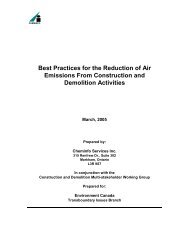Burrard Inlet Environmental Indicators Report - the BIEAP and ...
Burrard Inlet Environmental Indicators Report - the BIEAP and ...
Burrard Inlet Environmental Indicators Report - the BIEAP and ...
Create successful ePaper yourself
Turn your PDF publications into a flip-book with our unique Google optimized e-Paper software.
<strong>Burrard</strong> <strong>Inlet</strong> <strong>Environmental</strong> <strong>Indicators</strong> <strong>Report</strong> February 2008<br />
Chart 5-1: Total Annual Emissions of GHGs Within <strong>the</strong> <strong>Burrard</strong> <strong>Inlet</strong> Airshed<br />
(marine <strong>and</strong> l<strong>and</strong> sources, including vehicles)<br />
GHG emissions, CO2 equivalents<br />
(million tonnes/year)<br />
6<br />
5<br />
4<br />
3<br />
2<br />
1<br />
0<br />
1990 1995 2000 2005<br />
SOURCE: ESSA (2006)<br />
NOTES: Emissions of CH4 <strong>and</strong> N2O are calculated as CO2 equivalents. CH4 has 21 times more global warming<br />
potential than CO2 while N2O has 310 times more global warming potential<br />
Data from 2005 (dotted bar) represent a forecast based on 2000 data.<br />
What can we do to reduce GHG emissions?<br />
Government <strong>and</strong> industry-sponsored programs to reduce GHG emissions are important<br />
locally, nationally <strong>and</strong> globally. In many cases, a reduction in GHG emissions is linked with<br />
improvements in air quality (see Indicator 4). Integrated public transit infrastructure <strong>and</strong> smart<br />
urban design will reduce congestion <strong>and</strong> link people to workplaces <strong>and</strong> o<strong>the</strong>r destinations.<br />
Energy-wise community planning <strong>and</strong> <strong>the</strong> adoption of efficient building practices will improve<br />
energy efficiency <strong>and</strong> conservation.<br />
Examples of local programs to cap <strong>and</strong> reduce emissions in <strong>the</strong> <strong>Burrard</strong> <strong>Inlet</strong> watershed include:<br />
• municipal anti-idling by-laws, energy <strong>and</strong> GHG emissions planning, community planning<br />
• all <strong>Burrard</strong> <strong>Inlet</strong> municipalities are participants in <strong>the</strong> Federation of Canadian Municipalities’<br />
Partners for Climate Protection program, which aims to reduce GHG emissions<br />
• City of North Vancouver initiatives (community energy <strong>and</strong> greenhouse gas emissions<br />
planning, a Local Action Plan, establishing corporate <strong>and</strong> community reduction targets)<br />
• City of Port Moody initiatives (corporate energy <strong>and</strong> GHG emissions planning <strong>and</strong><br />
establishment of corporate <strong>and</strong> community reduction targets)<br />
• Metro Vancouver improvements to public transit <strong>and</strong> l<strong>and</strong> use planning<br />
• support for alternative fuels <strong>and</strong> energy technologies, energy efficiency <strong>and</strong><br />
conservation initiatives, green buildings<br />
• Vancouver Port Authority’s Integrated Air Emissions Reduction Program, with<br />
development of a data baseline, improving operational efficiency, technological<br />
innovation <strong>and</strong> supporting regulatory change<br />
• education <strong>and</strong> awareness programs<br />
N2O<br />
CH4<br />
CO2<br />
Page | 29
















